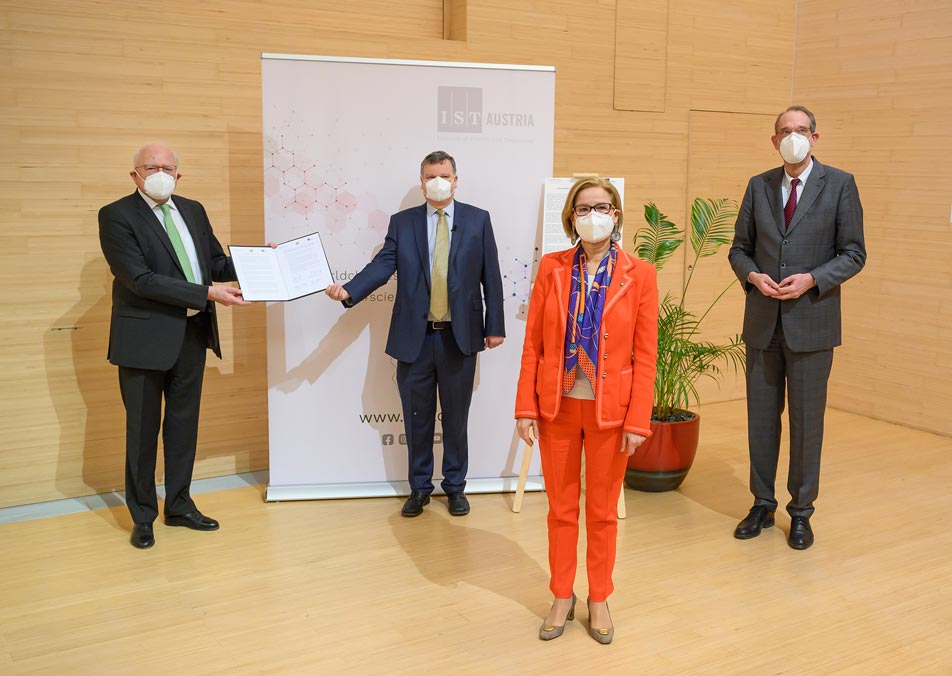A Memorandum of Understanding regarding the future of IST Austria
In 2006, the Austrian Federal Government decided to found the Institute of Science and Technology Austria (IST Austria). The objective was and is establishing an institute for basic research that ranks among the best of the world; is based on international standards, including those regarding quality control; recruits excellent scientists of all nationalities and thereby also offers Austrians living abroad the incentive to return to Austria to conduct world-class research; offers its own, independent doctoral programs; and participates in various Austrian and international collaborations. In addition to its importance for Austria as a science and research location long-term, it should also make a significant contribution to the further development of the Austrian economy, high tech and society, particularly in the field of education.
Both bodies that maintain the Institute – the Federal Government, represented by the Federal Ministry of Education, Science and Research (BMBWF) and the State of Lower Austria – have committed to support the Institute in the long run. Within the framework of agreements per Art. 15a of the Federal Constitution (B-VG), the maximum financial resources that are available for the establishment and further growth of the Institute were divided for a period of ten years each between the Federal and State Governments according to cost types. The current agreement will run until 2026. However, this agreement shall already be replaced in 2021 by a new agreement between both bodies.
On January 19, 2019, Haim Harari (Chair of the Executive Committee of IST Austria and former President of the Weizmann Institute of Science, Rehovot, Israel) and President Tom Henzinger presented a long-term concept for the further development of the Institute (IST Austria Vision beyond 2026). On the one hand, it confirms the founding principles that govern the Institute, on the other hand, it suggests new milestones for its development – by 2036, 150 professors should be able to do research on campus.
After conducting a comprehensive evaluation according to international standards in 2019, a top-class six-person Evaluation Panel, led by Physics Nobel laureate of 2012 Professor Serge Haroche, recommended that the growth rate of IST Austria should be maintained beyond 2026 in order, on the one hand, to reach the milestones related to further growth and, on the other hand, to maintain the dynamic research development.
In order for IST Austria to achieve its mission, the legislator has transferred a high level of autonomy to IST Austria. Within the limits of available funding, this autonomy applies to the choice of research topics and the content of scientific work, staff selection and the salary range of all employees, internal structures, career models and doctoral programs, rules regarding the appointment and promotion of professors, as well as regarding scientific quality control and the handling of intellectual property, planning of the scientific infrastructure and the campus, as well as all other matters that concern scientific work and the internal organization of IST Austria.
The Research Funding Act of 2020 created a special legal basis for research funding for the first time, which guarantees long-term financial and planning security for IST Austria alongside the Agreement per Art. 15a of the B-VG. As of 2021, three-year public law contracts will be concluded with the Institute. Furthermore, the amendment to the IST Austria Law created the possibility of IST Austria offering combined Master/PhD degrees.
With this Memorandum of Understanding, both bodies that maintain the Institute document their recognition of the world-class achievements that IST Austria has accomplished within a very short time and not only reinforce the shared ideas regarding the further development path of the Institute, but also start negotiations concerning a new 15a B-VG Agreement. The cornerstones of this agreement are as follows:
1. The existing Art. 15a B-VG agreement that is valid until 2026, shall, as far as possible, be replaced by a new agreement between both bodies in 2021.
2. Instead of the current distribution of the funding according to cost types, the next 15a B-VG agreement shall feature a percentage distribution between both bodies, the Federal Government and the State of Lower Austria.
3. Both bodies that maintain the Institute will follow the recommendation of the international Evaluation Panel of 2019, which was composed of, among others, two Nobel laureates and one Turing laureate, and the recent OECD Review (OECD REVIEWS OF INNOVATION POLICY: AUSTRIA 2018, Paris 2018, p.32), by not only reiterating their willingness to continue to optimally support the long-term objectives of the Institute, but also committing to establish the financial conditions allowing for further successful development of IST Austria by means of further growth of the Institute beyond 2026 in the Agreement per Art. 15a B-VG that is to be negotiated in 2021, to ensure the dynamic development of the research portfolio of the Institute.
4. The State of Lower Austria guarantees that any future building activity on or encumbrance of the vacant areas on the site that is included in the agreement per Article 15a B-VG concerning the formation and operation of the Institute of Science and Technology Austria, BGBl. No. 107/2006, is linked to the consent of IST Austria. A different exploitation of the vacant areas by the State of Lower Austria or third parties is not possible without the approval of IST Austria. Furthermore, IST Austria is entitled to construct “Superädifikate” (properties on third-party land).
5. The State of Lower Austria will stand by the existing lease and refrain from a one-sided termination or changes to the rent.



